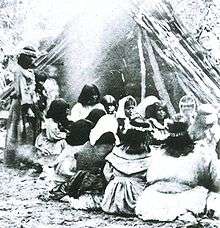Wilton Rancheria
 | |
| Total population | |
|---|---|
| 700+ (enrolled members) | |
| Regions with significant populations | |
|
| |
| Languages | |
|
English, historically Central Sierra Miwok language | |
| Related ethnic groups | |
| other Miwok tribes |
Wilton Rancheria is a federally recognized Native American tribe of Miwok people.[1] They were formed from Wilton Rancheria Miwok and the Me-Wuk Indian Community of the Wilton Rancheria.[2]
The Wilton Rancheria has more than 700 enrolled members, 62% of the enrolled population resides in Southern Sacramento County.[3] The rancheria (or reservation) consists of 38.5 acres (156,000 m2) of land[4] located in the Sacramento Valley, near the city of Elk Grove, CA in the census-designated place of Wilton, California.
Government
The tribe is headquartered in Elk Grove, California. The tribe has nine elected tribal officials.[3]
There are also four branches of government, which are the Executive Branch, the Legislative Branch, Judicial Branch, and the General Council. Each play an important role in how the Tribe is run and the governing laws and rules are decided. The general council consists of all eligible voters of the Wilton Rancheria Tribe. Meetings of the general council are usually held annually or whenever one is needed.[3]
The current elected officials are as follows:
Chair: Raymond Hitchcock
Vice-Chair: Cammeron Hodson
Tribal Council Spokesperson: Tonya Caldwell
Tribal Council Vice Spokesperson: David Andrews
Tribal Council Members: Mark Andrews, Jesus Tarango, Elizabeth Singh, Annette Williams, and Joseph Rangel
Branches of Government
The Wilton Rancheria Tribe has four branches of government, which are the: Executive Branch, Legislative Branch, Judicial Branch, and the General Council. Each of which are responsible for different aspects of the tribe.
The Executive Branch is responsible for proposing legislation and annual tribal budget to the Legislative Branch and negotiating and entering into treaties. This branch is usually headed by the Chairperson and the Vice-Chairperson.
The Legislative Branch is responsible for making laws and regulations, authorizing expenditures, and promoting social advancement of the tribe as a whole. The members of the tribal council serve in staggered four-year terms.
The Judicial Branch acts as the tribe's Tribal Court, which is responsible for jurisdiction over all criminal and civil cases. Though the Tribal Court has not yet been implemented, the framework for its structure has already been laid out by the Constitution and the laws of the tribe.
Then there is the General Council which consists of all the eligible voters of Wilton Rancheria. The General Council is able to propose amendments to the Constitution, approving them and removing tribal officials.
History
For many years, ancestors of the Wilton Rancheria Miwok lived along the Cosumnes River until 1958. The tribal members are descendants of the Plains and Sierra Miwok who lived and prospered in the Sacramento Valley.[5] In their own language, mi-wuk means "people".[6]
The tribe was re-recognized as a federal tribe on June 13, 2009,[7] after being terminated in 1958 under the California Rancheria Act, an Indian termination policy.
Between March 1851 and January 1852, three commissioners negotiated eighteen treaties with representatives of some of the indigenous population in California, but were never discussed in Congress and were hidden away for more than 50 years.
After termination, the Wilton Rancheria Tribe suffered long-term effects such as a: 62% unemployment rate, median annual income of $2,000, 38% without health insurance, and a college graduation rate of 14%.[3] In the 1970s, the Wilton Rancheria's policy of termination was reconsidered by Congress in favor of Indian self-determination. The Tribe reorganized their government in the 90s and officially requested the US to formally restore their federal recognition. They didn't receive a decision until 10 years later from the US District Court Judge. A Constitution was passed in 2011 for their tribe, which set up the framework for a structural government.
The Federal Register, Vol. 78, No. 176, Notices 55731, states that the Tribe is designated boundaries of the Service Delivery Area (SDA) of Sacramento County in the State of California.
From here, the Tribe has only been growing and will soon be establishing their Wilton Rancheria Elk Grove Resort and Casino. This will bring them more income as well as an influx of customers and visitors.
See also
Notes
- ↑ "Restoration of Wilton Rancheria", Federal Register Vol. 74, No. 132, p.33468-33469 (July 13, 2009). Retrieved on 2009-09-03.
- ↑ Me-Wuk Indian Community of the Wilton Rancheria. Retrieved on 2009-09-03.
- 1 2 3 4 "Tribal Profile". wiltonrancheria-nsn.gov. Retrieved 2018-04-16.
- ↑ "About Rancheria" Official Wilton Rancheria website. Retrieved on 2009-09-03.
- ↑ "Wilton Rancheria Announces Restoration of Status as Federally Recognized Indian Tribe", Sacramento Business Journal, 2009-06-08. Retrieved on 2009-09-03.
- ↑ Me-Wuk-English Glossary. Retrieved 2009-09-03.
- ↑ "Wilton Miwok Rancheria tribe outlines future goals" Elk Grove Citizen, 2009-07-07. Retrieved on 2009-09-03.